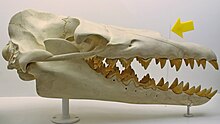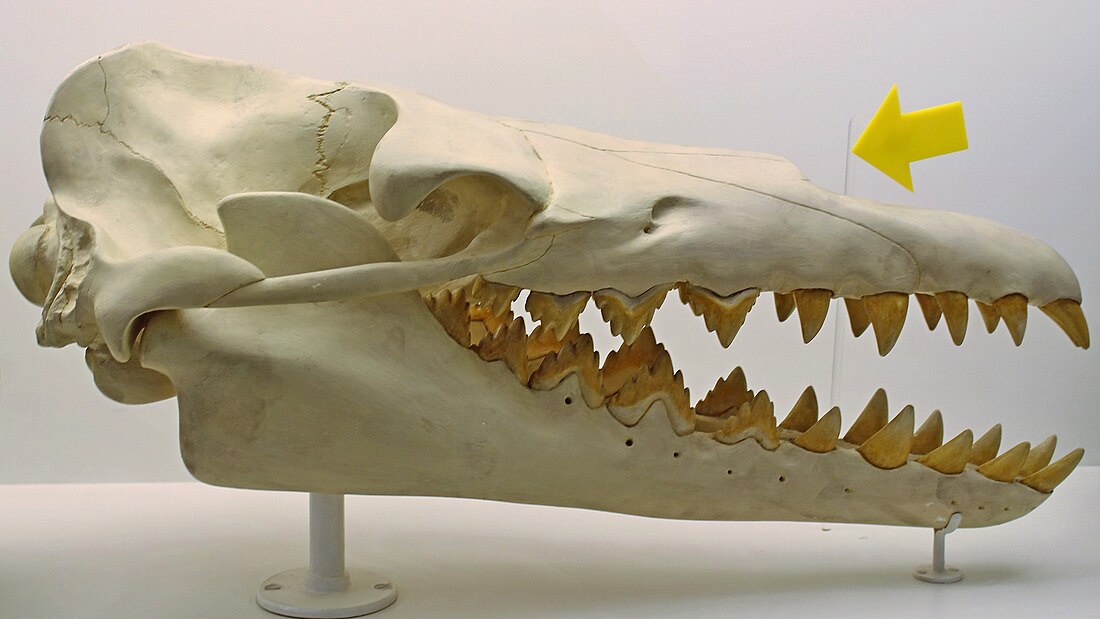Basilosauridae is a family of extinct cetaceans. They lived during the middle to the early late Eocene and are known from all continents, including Antarctica.[1][2] They were probably the first fully aquatic cetaceans.[3][4] The group is noted to be a paraphyletic assemblage of stem group whales[5] from which the monophyletic Neoceti are derived.[6]
| Basilosauridae | |
|---|---|
 | |
| Skull of the genus Saghacetus. | |
| Scientific classification | |
| Domain: | Eukaryota |
| Kingdom: | Animalia |
| Phylum: | Chordata |
| Class: | Mammalia |
| Order: | Artiodactyla |
| Infraorder: | Cetacea |
| Family: | †Basilosauridae Cope 1868[1] |
| Genera | |
|
See text | |
Characteristics



Basilosaurids ranged in size from 4 to 16 m (13 to 52 ft) and were fairly similar to modern cetaceans in overall body form and function.[7] Some genera tend to show signs of convergent evolution with mosasaurs by having long serpentine body shape, which suggests that this body plan seems to have been rather successful.[8] Basilosaurid forelimbs have broad and fan-shaped scapulae attached to a humerus, radius, and ulna which are flattened into a plane to which the elbow joint was restricted, effectively making pronation and supination impossible. Because of a shortage of forelimb fossils from other archaeocetes, it is not known if this arrangement is unique to basilosaurids, as some of the characteristics are also seen in Georgiacetus.[3]
As archaeocetes, Basilosaurids lacked the telescoping skull of present whales. Their jaws were powerful,[9] with a dentition easily distinguishable from that of other archaeocetes: they lack upper third molars and the upper molars lack protocones, trigon basins, and lingual third roots. The cheek teeth have well-developed accessory denticles.
Unlike modern whales, basilosaurids possessed small hindlimbs with well defined femur, lower leg and feet. They were, however, very small and did not articulate with the vertebral column, which also lack true sacral vertebrae.[3] While they were unable to support body weight on land, they might have assisted as claspers during copulation.[10] Analysis of tail vertebrate from Basilosaurus and Dorudon indicate they possessed small flukes.[11]
Taxonomy
Basilosaurinae was proposed as a subfamily containing two genera: Basilosaurus and Basiloterus.[12] They were characterized by elongated distal thoracic vertebrae, lumbar, and proximal sacrococcygeal. All known members of the subfamily are larger than their relatives of the Dorudontinae subfamily except Cynthiacetus.
Size
Basilosaurids have a diverse range of sizes. Tutcetus rayanensis, the smallest member, is about 2.51-2.55 meters (8 feet 3 inches - 8 feet 4 inches) long and weighs around 180.4-187.1 kilograms (398-412 pounds).[13] On the other hand, Basilosaurus cetoides is impressively long, reaching approximately 18 meters.[14] The largest known basilosaurid, Perucetus colossus, is believed to be even bigger, with a length of about 17–20 metres (56–66 ft) and possibly comparable to, if not larger than, the modern blue whale in terms of weight,[15] though other researchers argue that it was much lighter.[16][17]
Systematics
- Family Basilosauridae
- Subfamily Basilosaurinae
- Genus Basilosaurus
- Genus Basiloterus
- Subfamily Dorudontinae
- Genus Ancalecetus
- Genus Chrysocetus
- Genus Cynthiacetus
- Genus Dorudon
- Genus Masracetus
- Genus Ocucajea
- Genus Saghacetus
- Genus Stromerius
- Genus Supayacetus
- Genus Zygorhiza
- Subfamily Pachycetinae
- Genus Pachycetus
- Genus Antaecetus
See also
Notes
References
Wikiwand in your browser!
Seamless Wikipedia browsing. On steroids.
Every time you click a link to Wikipedia, Wiktionary or Wikiquote in your browser's search results, it will show the modern Wikiwand interface.
Wikiwand extension is a five stars, simple, with minimum permission required to keep your browsing private, safe and transparent.
